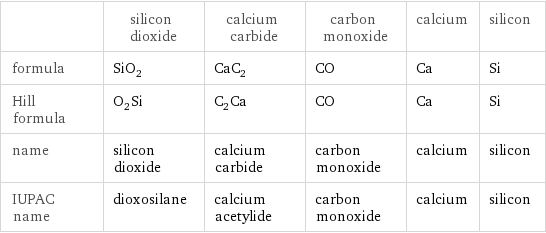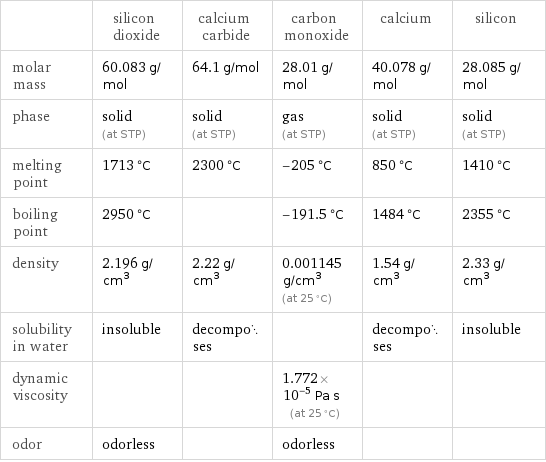Input interpretation

SiO_2 silicon dioxide + CaC_2 calcium carbide ⟶ CO carbon monoxide + Ca calcium + Si silicon
Balanced equation

Balance the chemical equation algebraically: SiO_2 + CaC_2 ⟶ CO + Ca + Si Add stoichiometric coefficients, c_i, to the reactants and products: c_1 SiO_2 + c_2 CaC_2 ⟶ c_3 CO + c_4 Ca + c_5 Si Set the number of atoms in the reactants equal to the number of atoms in the products for O, Si, C and Ca: O: | 2 c_1 = c_3 Si: | c_1 = c_5 C: | 2 c_2 = c_3 Ca: | c_2 = c_4 Since the coefficients are relative quantities and underdetermined, choose a coefficient to set arbitrarily. To keep the coefficients small, the arbitrary value is ordinarily one. For instance, set c_1 = 1 and solve the system of equations for the remaining coefficients: c_1 = 1 c_2 = 1 c_3 = 2 c_4 = 1 c_5 = 1 Substitute the coefficients into the chemical reaction to obtain the balanced equation: Answer: | | SiO_2 + CaC_2 ⟶ 2 CO + Ca + Si
Structures

+ ⟶ + +
Names

silicon dioxide + calcium carbide ⟶ carbon monoxide + calcium + silicon
Reaction thermodynamics
Enthalpy

| silicon dioxide | calcium carbide | carbon monoxide | calcium | silicon molecular enthalpy | -911 kJ/mol | -59.8 kJ/mol | -110.5 kJ/mol | 0 kJ/mol | 0 kJ/mol total enthalpy | -911 kJ/mol | -59.8 kJ/mol | -221 kJ/mol | 0 kJ/mol | 0 kJ/mol | H_initial = -970.8 kJ/mol | | H_final = -221 kJ/mol | | ΔH_rxn^0 | -221 kJ/mol - -970.8 kJ/mol = 749.8 kJ/mol (endothermic) | | | |
Equilibrium constant
![Construct the equilibrium constant, K, expression for: SiO_2 + CaC_2 ⟶ CO + Ca + Si Plan: • Balance the chemical equation. • Determine the stoichiometric numbers. • Assemble the activity expression for each chemical species. • Use the activity expressions to build the equilibrium constant expression. Write the balanced chemical equation: SiO_2 + CaC_2 ⟶ 2 CO + Ca + Si Assign stoichiometric numbers, ν_i, using the stoichiometric coefficients, c_i, from the balanced chemical equation in the following manner: ν_i = -c_i for reactants and ν_i = c_i for products: chemical species | c_i | ν_i SiO_2 | 1 | -1 CaC_2 | 1 | -1 CO | 2 | 2 Ca | 1 | 1 Si | 1 | 1 Assemble the activity expressions accounting for the state of matter and ν_i: chemical species | c_i | ν_i | activity expression SiO_2 | 1 | -1 | ([SiO2])^(-1) CaC_2 | 1 | -1 | ([CaC2])^(-1) CO | 2 | 2 | ([CO])^2 Ca | 1 | 1 | [Ca] Si | 1 | 1 | [Si] The equilibrium constant symbol in the concentration basis is: K_c Mulitply the activity expressions to arrive at the K_c expression: Answer: | | K_c = ([SiO2])^(-1) ([CaC2])^(-1) ([CO])^2 [Ca] [Si] = (([CO])^2 [Ca] [Si])/([SiO2] [CaC2])](../image_source/05e671826b366100b34b3d4ad87311de.png)
Construct the equilibrium constant, K, expression for: SiO_2 + CaC_2 ⟶ CO + Ca + Si Plan: • Balance the chemical equation. • Determine the stoichiometric numbers. • Assemble the activity expression for each chemical species. • Use the activity expressions to build the equilibrium constant expression. Write the balanced chemical equation: SiO_2 + CaC_2 ⟶ 2 CO + Ca + Si Assign stoichiometric numbers, ν_i, using the stoichiometric coefficients, c_i, from the balanced chemical equation in the following manner: ν_i = -c_i for reactants and ν_i = c_i for products: chemical species | c_i | ν_i SiO_2 | 1 | -1 CaC_2 | 1 | -1 CO | 2 | 2 Ca | 1 | 1 Si | 1 | 1 Assemble the activity expressions accounting for the state of matter and ν_i: chemical species | c_i | ν_i | activity expression SiO_2 | 1 | -1 | ([SiO2])^(-1) CaC_2 | 1 | -1 | ([CaC2])^(-1) CO | 2 | 2 | ([CO])^2 Ca | 1 | 1 | [Ca] Si | 1 | 1 | [Si] The equilibrium constant symbol in the concentration basis is: K_c Mulitply the activity expressions to arrive at the K_c expression: Answer: | | K_c = ([SiO2])^(-1) ([CaC2])^(-1) ([CO])^2 [Ca] [Si] = (([CO])^2 [Ca] [Si])/([SiO2] [CaC2])
Rate of reaction
![Construct the rate of reaction expression for: SiO_2 + CaC_2 ⟶ CO + Ca + Si Plan: • Balance the chemical equation. • Determine the stoichiometric numbers. • Assemble the rate term for each chemical species. • Write the rate of reaction expression. Write the balanced chemical equation: SiO_2 + CaC_2 ⟶ 2 CO + Ca + Si Assign stoichiometric numbers, ν_i, using the stoichiometric coefficients, c_i, from the balanced chemical equation in the following manner: ν_i = -c_i for reactants and ν_i = c_i for products: chemical species | c_i | ν_i SiO_2 | 1 | -1 CaC_2 | 1 | -1 CO | 2 | 2 Ca | 1 | 1 Si | 1 | 1 The rate term for each chemical species, B_i, is 1/ν_i(Δ[B_i])/(Δt) where [B_i] is the amount concentration and t is time: chemical species | c_i | ν_i | rate term SiO_2 | 1 | -1 | -(Δ[SiO2])/(Δt) CaC_2 | 1 | -1 | -(Δ[CaC2])/(Δt) CO | 2 | 2 | 1/2 (Δ[CO])/(Δt) Ca | 1 | 1 | (Δ[Ca])/(Δt) Si | 1 | 1 | (Δ[Si])/(Δt) (for infinitesimal rate of change, replace Δ with d) Set the rate terms equal to each other to arrive at the rate expression: Answer: | | rate = -(Δ[SiO2])/(Δt) = -(Δ[CaC2])/(Δt) = 1/2 (Δ[CO])/(Δt) = (Δ[Ca])/(Δt) = (Δ[Si])/(Δt) (assuming constant volume and no accumulation of intermediates or side products)](../image_source/0c1d17bca5787ff3f75c44d4b11d31e9.png)
Construct the rate of reaction expression for: SiO_2 + CaC_2 ⟶ CO + Ca + Si Plan: • Balance the chemical equation. • Determine the stoichiometric numbers. • Assemble the rate term for each chemical species. • Write the rate of reaction expression. Write the balanced chemical equation: SiO_2 + CaC_2 ⟶ 2 CO + Ca + Si Assign stoichiometric numbers, ν_i, using the stoichiometric coefficients, c_i, from the balanced chemical equation in the following manner: ν_i = -c_i for reactants and ν_i = c_i for products: chemical species | c_i | ν_i SiO_2 | 1 | -1 CaC_2 | 1 | -1 CO | 2 | 2 Ca | 1 | 1 Si | 1 | 1 The rate term for each chemical species, B_i, is 1/ν_i(Δ[B_i])/(Δt) where [B_i] is the amount concentration and t is time: chemical species | c_i | ν_i | rate term SiO_2 | 1 | -1 | -(Δ[SiO2])/(Δt) CaC_2 | 1 | -1 | -(Δ[CaC2])/(Δt) CO | 2 | 2 | 1/2 (Δ[CO])/(Δt) Ca | 1 | 1 | (Δ[Ca])/(Δt) Si | 1 | 1 | (Δ[Si])/(Δt) (for infinitesimal rate of change, replace Δ with d) Set the rate terms equal to each other to arrive at the rate expression: Answer: | | rate = -(Δ[SiO2])/(Δt) = -(Δ[CaC2])/(Δt) = 1/2 (Δ[CO])/(Δt) = (Δ[Ca])/(Δt) = (Δ[Si])/(Δt) (assuming constant volume and no accumulation of intermediates or side products)
Chemical names and formulas

| silicon dioxide | calcium carbide | carbon monoxide | calcium | silicon formula | SiO_2 | CaC_2 | CO | Ca | Si Hill formula | O_2Si | C_2Ca | CO | Ca | Si name | silicon dioxide | calcium carbide | carbon monoxide | calcium | silicon IUPAC name | dioxosilane | calcium acetylide | carbon monoxide | calcium | silicon
Substance properties

| silicon dioxide | calcium carbide | carbon monoxide | calcium | silicon molar mass | 60.083 g/mol | 64.1 g/mol | 28.01 g/mol | 40.078 g/mol | 28.085 g/mol phase | solid (at STP) | solid (at STP) | gas (at STP) | solid (at STP) | solid (at STP) melting point | 1713 °C | 2300 °C | -205 °C | 850 °C | 1410 °C boiling point | 2950 °C | | -191.5 °C | 1484 °C | 2355 °C density | 2.196 g/cm^3 | 2.22 g/cm^3 | 0.001145 g/cm^3 (at 25 °C) | 1.54 g/cm^3 | 2.33 g/cm^3 solubility in water | insoluble | decomposes | | decomposes | insoluble dynamic viscosity | | | 1.772×10^-5 Pa s (at 25 °C) | | odor | odorless | | odorless | |
Units
